tires JEEP PATRIOT 2021 Owner handbook (in English)
[x] Cancel search | Manufacturer: JEEP, Model Year: 2021, Model line: PATRIOT, Model: JEEP PATRIOT 2021Pages: 332, PDF Size: 1.99 MB
Page 196 of 332
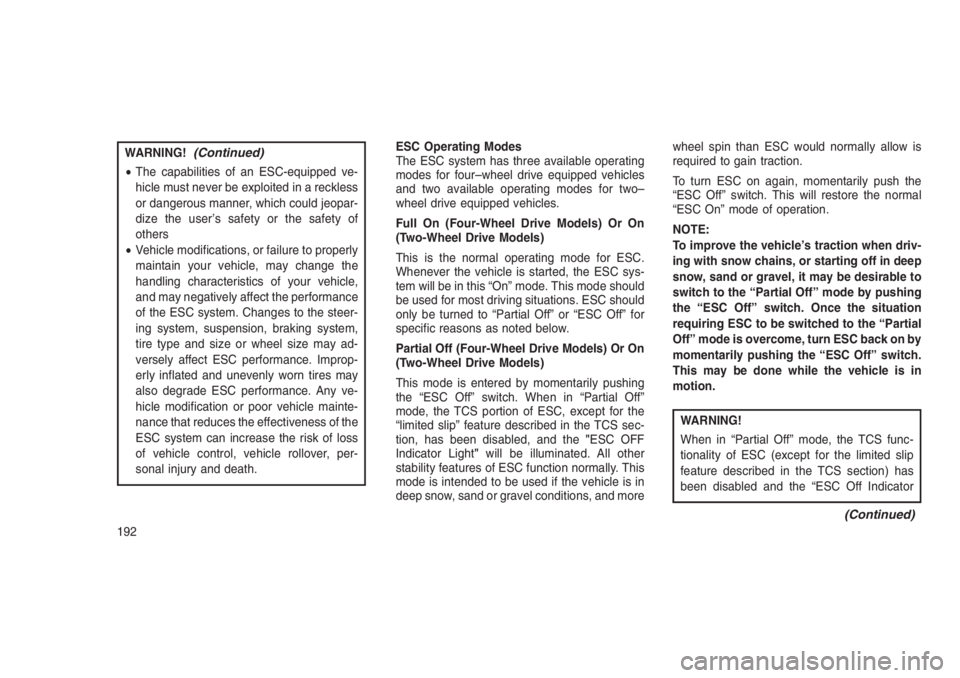
WARNING!(Continued)
•The capabilities of an ESC-equipped ve-
hicle must never be exploited in a reckless
or dangerous manner, which could jeopar-
dize the user’s safety or the safety of
others
•Vehicle modifications, or failure to properly
maintain your vehicle, may change the
handling characteristics of your vehicle,
and may negatively affect the performance
of the ESC system. Changes to the steer-
ing system, suspension, braking system,
tire type and size or wheel size may ad-
versely affect ESC performance. Improp-
erly inflated and unevenly worn tires may
also degrade ESC performance. Any ve-
hicle modification or poor vehicle mainte-
nance that reduces the effectiveness of the
ESC system can increase the risk of loss
of vehicle control, vehicle rollover, per-
sonal injury and death.ESC Operating Modes
The ESC system has three available operating
modes for four–wheel drive equipped vehicles
and two available operating modes for two–
wheel drive equipped vehicles.
Full On (Four-Wheel Drive Models) Or On
(Two-Wheel Drive Models)
This is the normal operating mode for ESC.
Whenever the vehicle is started, the ESC sys-
tem will be in this “On” mode. This mode should
be used for most driving situations. ESC should
only be turned to “Partial Off” or “ESC Off” for
specific reasons as noted below.
Partial Off (Four-Wheel Drive Models) Or On
(Two-Wheel Drive Models)
This mode is entered by momentarily pushing
the “ESC Off” switch. When in “Partial Off”
mode, the TCS portion of ESC, except for the
“limited slip” feature described in the TCS sec-
tion, has been disabled, and the"ESC OFF
Indicator Light"will be illuminated. All other
stability features of ESC function normally. This
mode is intended to be used if the vehicle is in
deep snow, sand or gravel conditions, and morewheel spin than ESC would normally allow is
required to gain traction.
To turn ESC on again, momentarily push the
“ESC Off” switch. This will restore the normal
“ESC On” mode of operation.
NOTE:
To improve the vehicle’s traction when driv-
ing with snow chains, or starting off in deep
snow, sand or gravel, it may be desirable to
switch to the “Partial Off” mode by pushing
the “ESC Off” switch. Once the situation
requiring ESC to be switched to the “Partial
Off” mode is overcome, turn ESC back on by
momentarily pushing the “ESC Off” switch.
This may be done while the vehicle is in
motion.
WARNING!
When in “Partial Off” mode, the TCS func-
tionality of ESC (except for the limited slip
feature described in the TCS section) has
been disabled and the “ESC Off Indicator
(Continued)
192
Page 198 of 332
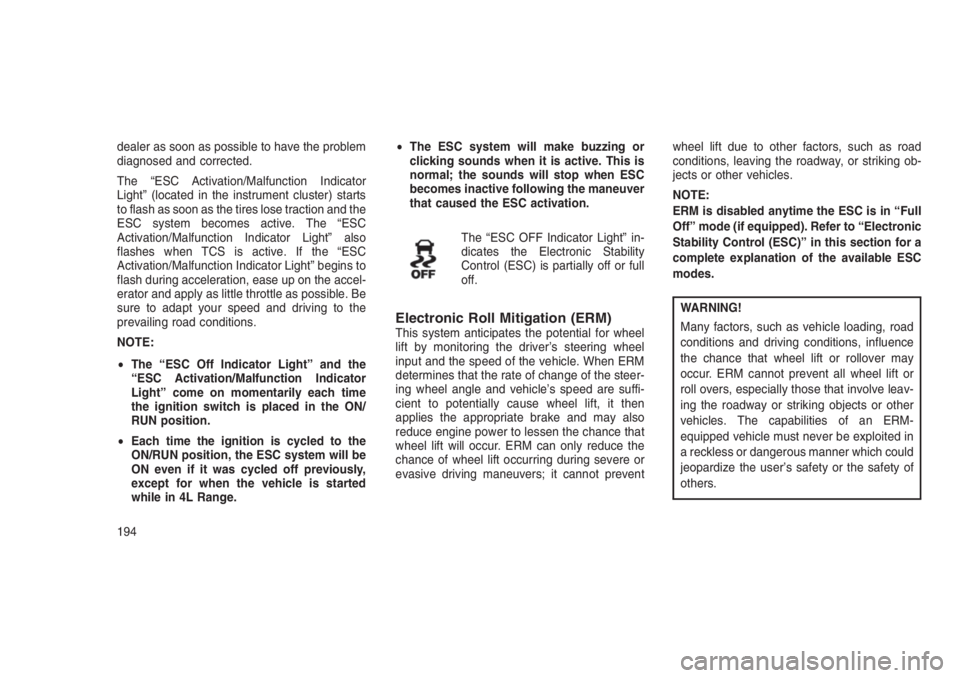
dealer as soon as possible to have the problem
diagnosed and corrected.
The “ESC Activation/Malfunction Indicator
Light” (located in the instrument cluster) starts
to flash as soon as the tires lose traction and the
ESC system becomes active. The “ESC
Activation/Malfunction Indicator Light” also
flashes when TCS is active. If the “ESC
Activation/Malfunction Indicator Light” begins to
flash during acceleration, ease up on the accel-
erator and apply as little throttle as possible. Be
sure to adapt your speed and driving to the
prevailing road conditions.
NOTE:
•The “ESC Off Indicator Light” and the
“ESC Activation/Malfunction Indicator
Light” come on momentarily each time
the ignition switch is placed in the ON/
RUN position.
•Each time the ignition is cycled to the
ON/RUN position, the ESC system will be
ON even if it was cycled off previously,
except for when the vehicle is started
while in 4L Range.•The ESC system will make buzzing or
clicking sounds when it is active. This is
normal; the sounds will stop when ESC
becomes inactive following the maneuver
that caused the ESC activation.
The “ESC OFF Indicator Light” in-
dicates the Electronic Stability
Control (ESC) is partially off or full
off.
Electronic Roll Mitigation (ERM)This system anticipates the potential for wheel
lift by monitoring the driver’s steering wheel
input and the speed of the vehicle. When ERM
determines that the rate of change of the steer-
ing wheel angle and vehicle’s speed are suffi-
cient to potentially cause wheel lift, it then
applies the appropriate brake and may also
reduce engine power to lessen the chance that
wheel lift will occur. ERM can only reduce the
chance of wheel lift occurring during severe or
evasive driving maneuvers; it cannot preventwheel lift due to other factors, such as road
conditions, leaving the roadway, or striking ob-
jects or other vehicles.
NOTE:
ERM is disabled anytime the ESC is in “Full
Off” mode (if equipped). Refer to “Electronic
Stability Control (ESC)” in this section for a
complete explanation of the available ESC
modes.
WARNING!
Many factors, such as vehicle loading, road
conditions and driving conditions, influence
the chance that wheel lift or rollover may
occur. ERM cannot prevent all wheel lift or
roll overs, especially those that involve leav-
ing the roadway or striking objects or other
vehicles. The capabilities of an ERM-
equipped vehicle must never be exploited in
a reckless or dangerous manner which could
jeopardize the user’s safety or the safety of
others.
194
Page 199 of 332
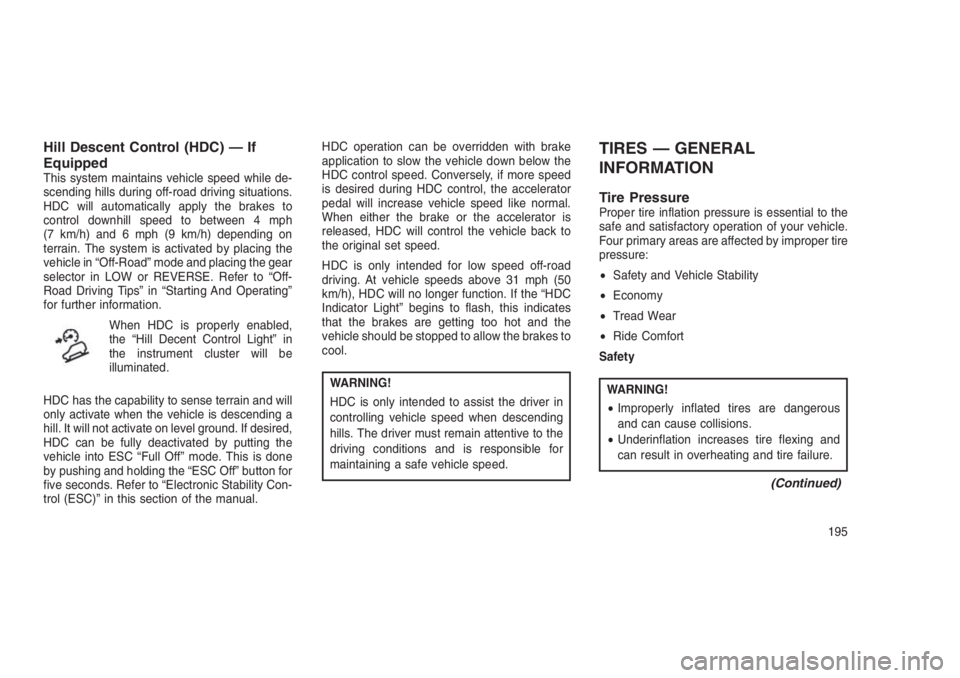
Hill Descent Control (HDC) — If
Equipped
This system maintains vehicle speed while de-
scending hills during off-road driving situations.
HDC will automatically apply the brakes to
control downhill speed to between 4 mph
(7 km/h) and 6 mph (9 km/h) depending on
terrain. The system is activated by placing the
vehicle in “Off-Road” mode and placing the gear
selector in LOW or REVERSE. Refer to “Off-
Road Driving Tips” in “Starting And Operating”
for further information.
When HDC is properly enabled,
the “Hill Decent Control Light” in
the instrument cluster will be
illuminated.
HDC has the capability to sense terrain and will
only activate when the vehicle is descending a
hill. It will not activate on level ground. If desired,
HDC can be fully deactivated by putting the
vehicle into ESC “Full Off” mode. This is done
by pushing and holding the “ESC Off” button for
five seconds. Refer to “Electronic Stability Con-
trol (ESC)” in this section of the manual.HDC operation can be overridden with brake
application to slow the vehicle down below the
HDC control speed. Conversely, if more speed
is desired during HDC control, the accelerator
pedal will increase vehicle speed like normal.
When either the brake or the accelerator is
released, HDC will control the vehicle back to
the original set speed.
HDC is only intended for low speed off-road
driving. At vehicle speeds above 31 mph (50
km/h), HDC will no longer function. If the “HDC
Indicator Light” begins to flash, this indicates
that the brakes are getting too hot and the
vehicle should be stopped to allow the brakes to
cool.
WARNING!
HDC is only intended to assist the driver in
controlling vehicle speed when descending
hills. The driver must remain attentive to the
driving conditions and is responsible for
maintaining a safe vehicle speed.
TIRES — GENERAL
INFORMATION
Tire PressureProper tire inflation pressure is essential to the
safe and satisfactory operation of your vehicle.
Four primary areas are affected by improper tire
pressure:
•Safety and Vehicle Stability
•Economy
•Tread Wear
•Ride Comfort
Safety
WARNING!
•Improperly inflated tires are dangerous
and can cause collisions.
•Underinflation increases tire flexing and
can result in overheating and tire failure.
(Continued)
195
Page 200 of 332
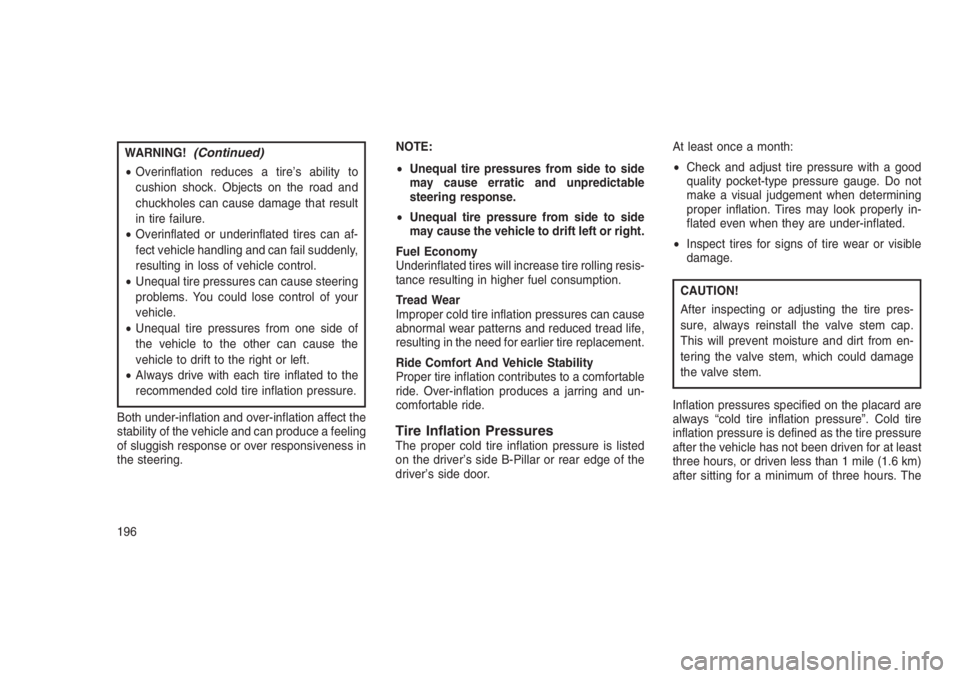
WARNING!(Continued)
•Overinflation reduces a tire’s ability to
cushion shock. Objects on the road and
chuckholes can cause damage that result
in tire failure.
•Overinflated or underinflated tires can af-
fect vehicle handling and can fail suddenly,
resulting in loss of vehicle control.
•Unequal tire pressures can cause steering
problems. You could lose control of your
vehicle.
•Unequal tire pressures from one side of
the vehicle to the other can cause the
vehicle to drift to the right or left.
•Always drive with each tire inflated to the
recommended cold tire inflation pressure.
Both under-inflation and over-inflation affect the
stability of the vehicle and can produce a feeling
of sluggish response or over responsiveness in
the steering.NOTE:
•Unequal tire pressures from side to side
may cause erratic and unpredictable
steering response.
•Unequal tire pressure from side to side
may cause the vehicle to drift left or right.
Fuel Economy
Underinflated tires will increase tire rolling resis-
tance resulting in higher fuel consumption.
Tread Wear
Improper cold tire inflation pressures can cause
abnormal wear patterns and reduced tread life,
resulting in the need for earlier tire replacement.
Ride Comfort And Vehicle Stability
Proper tire inflation contributes to a comfortable
ride. Over-inflation produces a jarring and un-
comfortable ride.
Tire Inflation PressuresThe proper cold tire inflation pressure is listed
on the driver’s side B-Pillar or rear edge of the
driver’s side door.At least once a month:
•Check and adjust tire pressure with a good
quality pocket-type pressure gauge. Do not
make a visual judgement when determining
proper inflation. Tires may look properly in-
flated even when they are under-inflated.
•Inspect tires for signs of tire wear or visible
damage.
CAUTION!
After inspecting or adjusting the tire pres-
sure, always reinstall the valve stem cap.
This will prevent moisture and dirt from en-
tering the valve stem, which could damage
the valve stem.
Inflation pressures specified on the placard are
always “cold tire inflation pressure”. Cold tire
inflation pressure is defined as the tire pressure
after the vehicle has not been driven for at least
three hours, or driven less than 1 mile (1.6 km)
after sitting for a minimum of three hours. The
196
Page 201 of 332
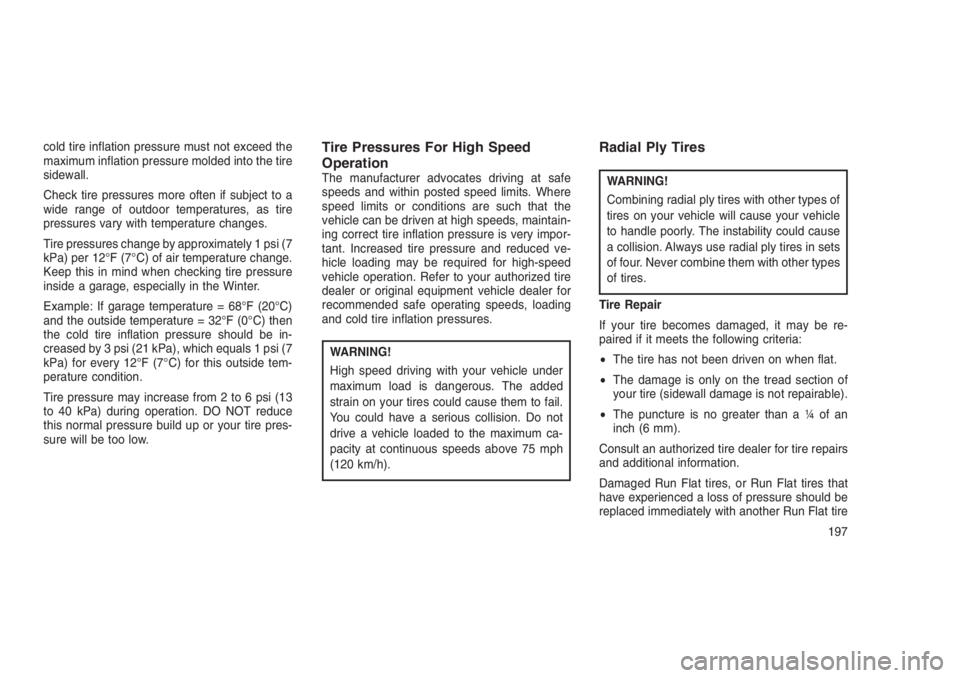
cold tire inflation pressure must not exceed the
maximum inflation pressure molded into the tire
sidewall.
Check tire pressures more often if subject to a
wide range of outdoor temperatures, as tire
pressures vary with temperature changes.
Tire pressures change by approximately 1 psi (7
kPa) per 12°F (7°C) of air temperature change.
Keep this in mind when checking tire pressure
inside a garage, especially in the Winter.
Example: If garage temperature = 68°F (20°C)
and the outside temperature = 32°F (0°C) then
the cold tire inflation pressure should be in-
creased by 3 psi (21 kPa), which equals 1 psi (7
kPa) for every 12°F (7°C) for this outside tem-
perature condition.
Tire pressure may increase from 2 to 6 psi (13
to 40 kPa) during operation. DO NOT reduce
this normal pressure build up or your tire pres-
sure will be too low.Tire Pressures For High Speed
Operation
The manufacturer advocates driving at safe
speeds and within posted speed limits. Where
speed limits or conditions are such that the
vehicle can be driven at high speeds, maintain-
ing correct tire inflation pressure is very impor-
tant. Increased tire pressure and reduced ve-
hicle loading may be required for high-speed
vehicle operation. Refer to your authorized tire
dealer or original equipment vehicle dealer for
recommended safe operating speeds, loading
and cold tire inflation pressures.
WARNING!
High speed driving with your vehicle under
maximum load is dangerous. The added
strain on your tires could cause them to fail.
You could have a serious collision. Do not
drive a vehicle loaded to the maximum ca-
pacity at continuous speeds above 75 mph
(120 km/h).
Radial Ply Tires
WARNING!
Combining radial ply tires with other types of
tires on your vehicle will cause your vehicle
to handle poorly. The instability could cause
a collision. Always use radial ply tires in sets
of four. Never combine them with other types
of tires.
Tire Repair
If your tire becomes damaged, it may be re-
paired if it meets the following criteria:
•The tire has not been driven on when flat.
•The damage is only on the tread section of
your tire (sidewall damage is not repairable).
•The puncture is no greater thana¼ofan
inch (6 mm).
Consult an authorized tire dealer for tire repairs
and additional information.
Damaged Run Flat tires, or Run Flat tires that
have experienced a loss of pressure should be
replaced immediately with another Run Flat tire
197
Page 202 of 332
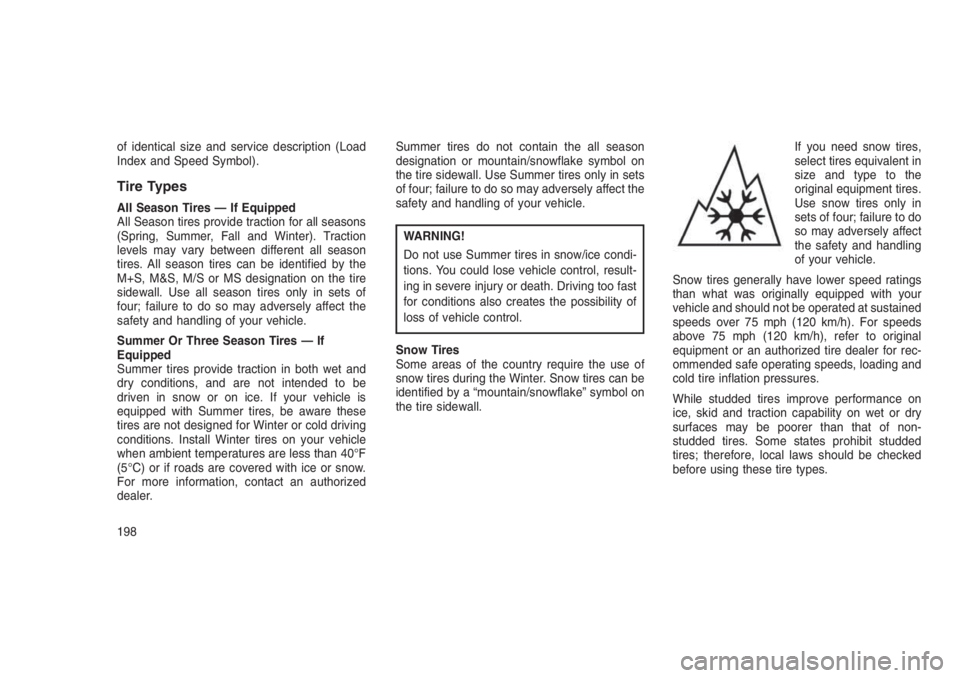
of identical size and service description (Load
Index and Speed Symbol).
Tire Types
All Season Tires — If Equipped
All Season tires provide traction for all seasons
(Spring, Summer, Fall and Winter). Traction
levels may vary between different all season
tires. All season tires can be identified by the
M+S, M&S, M/S or MS designation on the tire
sidewall. Use all season tires only in sets of
four; failure to do so may adversely affect the
safety and handling of your vehicle.
Summer Or Three Season Tires — If
Equipped
Summer tires provide traction in both wet and
dry conditions, and are not intended to be
driven in snow or on ice. If your vehicle is
equipped with Summer tires, be aware these
tires are not designed for Winter or cold driving
conditions. Install Winter tires on your vehicle
when ambient temperatures are less than 40°F
(5°C) or if roads are covered with ice or snow.
For more information, contact an authorized
dealer.Summer tires do not contain the all season
designation or mountain/snowflake symbol on
the tire sidewall. Use Summer tires only in sets
of four; failure to do so may adversely affect the
safety and handling of your vehicle.
WARNING!
Do not use Summer tires in snow/ice condi-
tions. You could lose vehicle control, result-
ing in severe injury or death. Driving too fast
for conditions also creates the possibility of
loss of vehicle control.
Snow Tires
Some areas of the country require the use of
snow tires during the Winter. Snow tires can be
identified by a “mountain/snowflake” symbol on
the tire sidewall.If you need snow tires,
select tires equivalent in
size and type to the
original equipment tires.
Use snow tires only in
sets of four; failure to do
so may adversely affect
the safety and handling
of your vehicle.
Snow tires generally have lower speed ratings
than what was originally equipped with your
vehicle and should not be operated at sustained
speeds over 75 mph (120 km/h). For speeds
above 75 mph (120 km/h), refer to original
equipment or an authorized tire dealer for rec-
ommended safe operating speeds, loading and
cold tire inflation pressures.
While studded tires improve performance on
ice, skid and traction capability on wet or dry
surfaces may be poorer than that of non-
studded tires. Some states prohibit studded
tires; therefore, local laws should be checked
before using these tire types.
198
Page 203 of 332
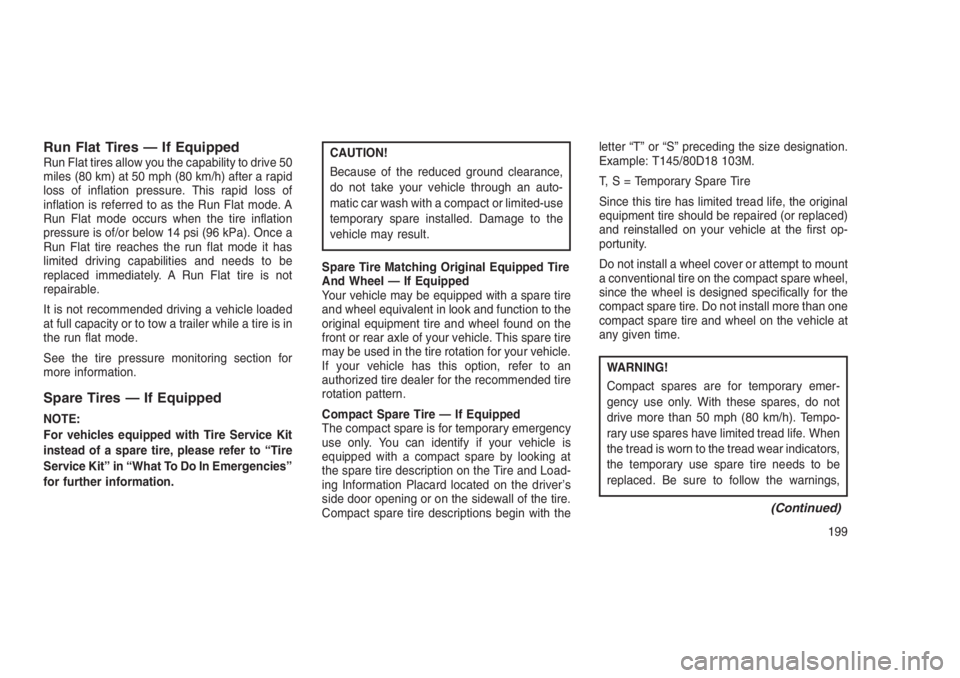
Run Flat Tires — If EquippedRun Flat tires allow you the capability to drive 50
miles (80 km) at 50 mph (80 km/h) after a rapid
loss of inflation pressure. This rapid loss of
inflation is referred to as the Run Flat mode. A
Run Flat mode occurs when the tire inflation
pressure is of/or below 14 psi (96 kPa). Once a
Run Flat tire reaches the run flat mode it has
limited driving capabilities and needs to be
replaced immediately. A Run Flat tire is not
repairable.
It is not recommended driving a vehicle loaded
at full capacity or to tow a trailer while a tire is in
the run flat mode.
See the tire pressure monitoring section for
more information.
Spare Tires — If Equipped
NOTE:
For vehicles equipped with Tire Service Kit
instead of a spare tire, please refer to “Tire
Service Kit” in “What To Do In Emergencies”
for further information.
CAUTION!
Because of the reduced ground clearance,
do not take your vehicle through an auto-
matic car wash with a compact or limited-use
temporary spare installed. Damage to the
vehicle may result.
Spare Tire Matching Original Equipped Tire
And Wheel — If Equipped
Your vehicle may be equipped with a spare tire
and wheel equivalent in look and function to the
original equipment tire and wheel found on the
front or rear axle of your vehicle. This spare tire
may be used in the tire rotation for your vehicle.
If your vehicle has this option, refer to an
authorized tire dealer for the recommended tire
rotation pattern.
Compact Spare Tire — If Equipped
The compact spare is for temporary emergency
use only. You can identify if your vehicle is
equipped with a compact spare by looking at
the spare tire description on the Tire and Load-
ing Information Placard located on the driver’s
side door opening or on the sidewall of the tire.
Compact spare tire descriptions begin with theletter “T” or “S” preceding the size designation.
Example: T145/80D18 103M.
T, S = Temporary Spare Tire
Since this tire has limited tread life, the original
equipment tire should be repaired (or replaced)
and reinstalled on your vehicle at the first op-
portunity.
Do not install a wheel cover or attempt to mount
a conventional tire on the compact spare wheel,
since the wheel is designed specifically for the
compact spare tire. Do not install more than one
compact spare tire and wheel on the vehicle at
any given time.
WARNING!
Compact spares are for temporary emer-
gency use only. With these spares, do not
drive more than 50 mph (80 km/h). Tempo-
rary use spares have limited tread life. When
the tread is worn to the tread wear indicators,
the temporary use spare tire needs to be
replaced. Be sure to follow the warnings,
(Continued)
199
Page 204 of 332
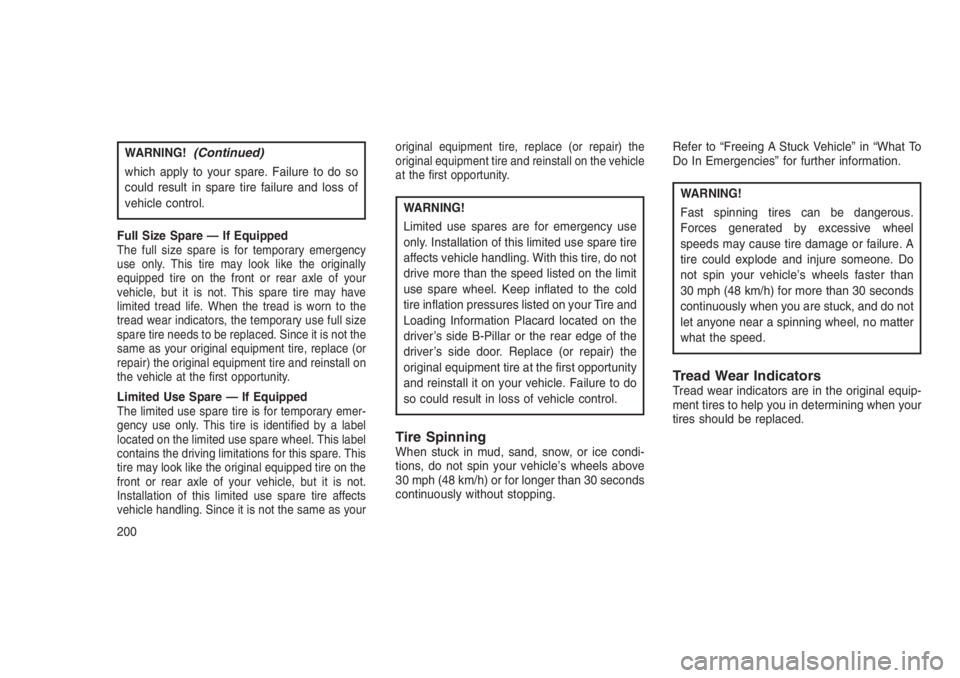
WARNING!(Continued)
which apply to your spare. Failure to do so
could result in spare tire failure and loss of
vehicle control.
Full Size Spare — If Equipped
The full size spare is for temporary emergency
use only. This tire may look like the originally
equipped tire on the front or rear axle of your
vehicle, but it is not. This spare tire may have
limited tread life. When the tread is worn to the
tread wear indicators, the temporary use full size
spare tire needs to be replaced. Since it is not the
same as your original equipment tire, replace (or
repair) the original equipment tire and reinstall on
the vehicle at the first opportunity.
Limited Use Spare — If EquippedThe limited use spare tire is for temporary emer-
gency use only. This tire is identified by a label
located on the limited use spare wheel. This label
contains the driving limitations for this spare. This
tire may look like the original equipped tire on the
front or rear axle of your vehicle, but it is not.
Installation of this limited use spare tire affects
vehicle handling. Since it is not the same as youroriginal equipment tire, replace (or repair) the
original equipment tire and reinstall on the vehicle
at the first opportunity.
WARNING!
Limited use spares are for emergency use
only. Installation of this limited use spare tire
affects vehicle handling. With this tire, do not
drive more than the speed listed on the limit
use spare wheel. Keep inflated to the cold
tire inflation pressures listed on your Tire and
Loading Information Placard located on the
driver’s side B-Pillar or the rear edge of the
driver’s side door. Replace (or repair) the
original equipment tire at the first opportunity
and reinstall it on your vehicle. Failure to do
so could result in loss of vehicle control.
Tire SpinningWhen stuck in mud, sand, snow, or ice condi-
tions, do not spin your vehicle’s wheels above
30 mph (48 km/h) or for longer than 30 seconds
continuously without stopping.Refer to “Freeing A Stuck Vehicle” in “What To
Do In Emergencies” for further information.
WARNING!
Fast spinning tires can be dangerous.
Forces generated by excessive wheel
speeds may cause tire damage or failure. A
tire could explode and injure someone. Do
not spin your vehicle’s wheels faster than
30 mph (48 km/h) for more than 30 seconds
continuously when you are stuck, and do not
let anyone near a spinning wheel, no matter
what the speed.
Tread Wear IndicatorsTread wear indicators are in the original equip-
ment tires to help you in determining when your
tires should be replaced.
200
Page 205 of 332
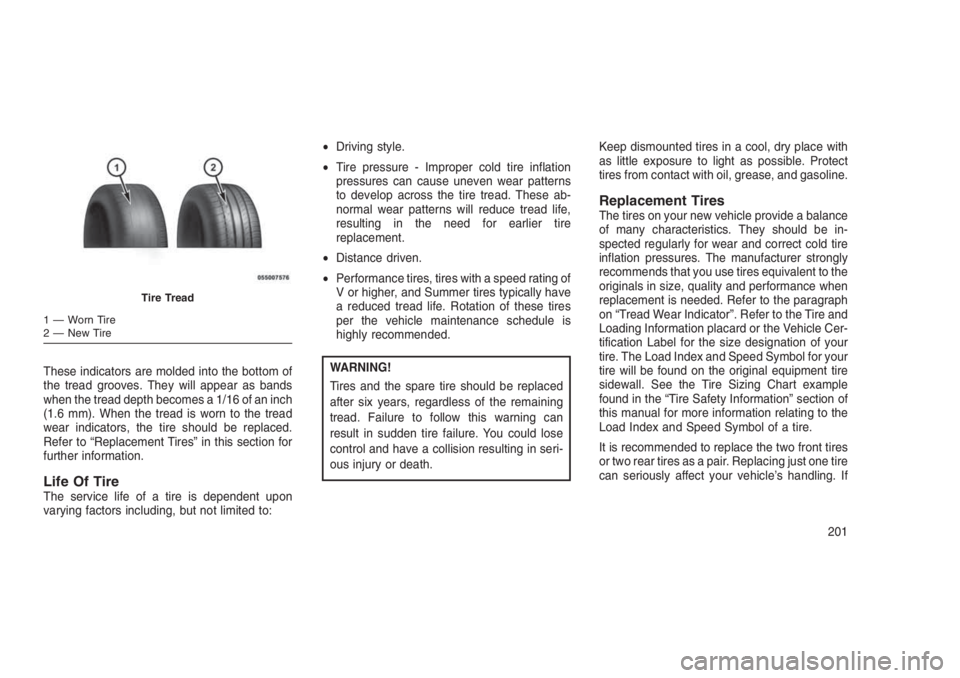
These indicators are molded into the bottom of
the tread grooves. They will appear as bands
when the tread depth becomes a 1/16 of an inch
(1.6 mm). When the tread is worn to the tread
wear indicators, the tire should be replaced.
Refer to “Replacement Tires” in this section for
further information.
Life Of TireThe service life of a tire is dependent upon
varying factors including, but not limited to:•Driving style.
•Tire pressure - Improper cold tire inflation
pressures can cause uneven wear patterns
to develop across the tire tread. These ab-
normal wear patterns will reduce tread life,
resulting in the need for earlier tire
replacement.
•Distance driven.
•Performance tires, tires with a speed rating of
V or higher, and Summer tires typically have
a reduced tread life. Rotation of these tires
per the vehicle maintenance schedule is
highly recommended.
WARNING!
Tires and the spare tire should be replaced
after six years, regardless of the remaining
tread. Failure to follow this warning can
result in sudden tire failure. You could lose
control and have a collision resulting in seri-
ous injury or death.Keep dismounted tires in a cool, dry place with
as little exposure to light as possible. Protect
tires from contact with oil, grease, and gasoline.
Replacement TiresThe tires on your new vehicle provide a balance
of many characteristics. They should be in-
spected regularly for wear and correct cold tire
inflation pressures. The manufacturer strongly
recommends that you use tires equivalent to the
originals in size, quality and performance when
replacement is needed. Refer to the paragraph
on “Tread Wear Indicator”. Refer to the Tire and
Loading Information placard or the Vehicle Cer-
tification Label for the size designation of your
tire. The Load Index and Speed Symbol for your
tire will be found on the original equipment tire
sidewall. See the Tire Sizing Chart example
found in the “Tire Safety Information” section of
this manual for more information relating to the
Load Index and Speed Symbol of a tire.
It is recommended to replace the two front tires
or two rear tires as a pair. Replacing just one tire
can seriously affect your vehicle’s handling. If
Tire Tread
1 — Worn Tire
2 — New Tire
201
Page 206 of 332
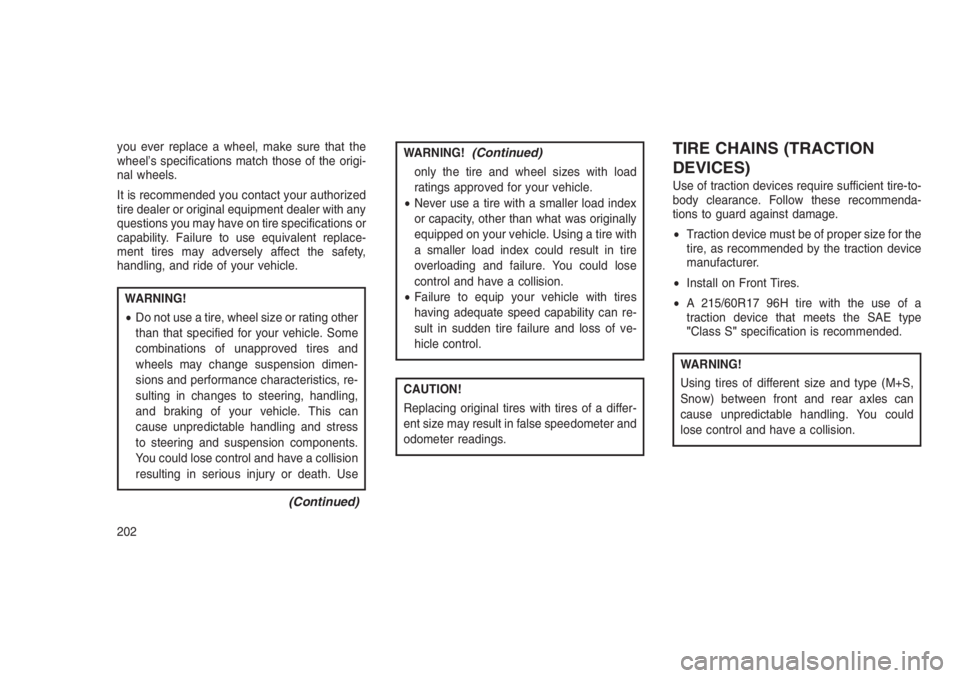
you ever replace a wheel, make sure that the
wheel’s specifications match those of the origi-
nal wheels.
It is recommended you contact your authorized
tire dealer or original equipment dealer with any
questions you may have on tire specifications or
capability. Failure to use equivalent replace-
ment tires may adversely affect the safety,
handling, and ride of your vehicle.
WARNING!
•Do not use a tire, wheel size or rating other
than that specified for your vehicle. Some
combinations of unapproved tires and
wheels may change suspension dimen-
sions and performance characteristics, re-
sulting in changes to steering, handling,
and braking of your vehicle. This can
cause unpredictable handling and stress
to steering and suspension components.
You could lose control and have a collision
resulting in serious injury or death. Use
(Continued)
WARNING!(Continued)
only the tire and wheel sizes with load
ratings approved for your vehicle.
•Never use a tire with a smaller load index
or capacity, other than what was originally
equipped on your vehicle. Using a tire with
a smaller load index could result in tire
overloading and failure. You could lose
control and have a collision.
•Failure to equip your vehicle with tires
having adequate speed capability can re-
sult in sudden tire failure and loss of ve-
hicle control.
CAUTION!
Replacing original tires with tires of a differ-
ent size may result in false speedometer and
odometer readings.
TIRE CHAINS (TRACTION
DEVICES)
Use of traction devices require sufficient tire-to-
body clearance. Follow these recommenda-
tions to guard against damage.
•Traction device must be of proper size for the
tire, as recommended by the traction device
manufacturer.
•Install on Front Tires.
•A 215/60R17 96H tire with the use of a
traction device that meets the SAE type
"Class S"specification is recommended.
WARNING!
Using tires of different size and type (M+S,
Snow) between front and rear axles can
cause unpredictable handling. You could
lose control and have a collision.
202